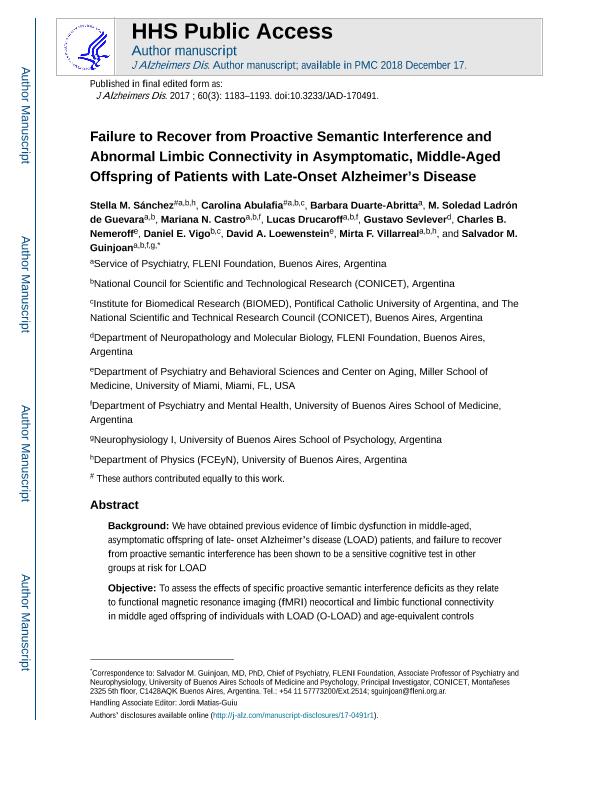Artículo
Failure to Recover from Proactive Semantic Interference and Abnormal Limbic Connectivity in Asymptomatic, Middle-Aged Offspring of Patients with Late-Onset Alzheimer’s Disease
Sanchez, Stella Maris ; Abulafia, Carolina Andrea
; Abulafia, Carolina Andrea ; Duarte Abritta, Barbara; Ladrón de Guevara, Maria Soledad
; Duarte Abritta, Barbara; Ladrón de Guevara, Maria Soledad ; Castro, Mariana Nair
; Castro, Mariana Nair ; Drucaroff, Lucas Javier
; Drucaroff, Lucas Javier ; Sevlever, Gustavo; Nemeroff, Charles B.; Vigo, Daniel Eduardo
; Sevlever, Gustavo; Nemeroff, Charles B.; Vigo, Daniel Eduardo ; Loewenstein, David A.; Villarreal, Mirta Fabiana
; Loewenstein, David A.; Villarreal, Mirta Fabiana ; Guinjoan, Salvador Martín
; Guinjoan, Salvador Martín
 ; Abulafia, Carolina Andrea
; Abulafia, Carolina Andrea ; Duarte Abritta, Barbara; Ladrón de Guevara, Maria Soledad
; Duarte Abritta, Barbara; Ladrón de Guevara, Maria Soledad ; Castro, Mariana Nair
; Castro, Mariana Nair ; Drucaroff, Lucas Javier
; Drucaroff, Lucas Javier ; Sevlever, Gustavo; Nemeroff, Charles B.; Vigo, Daniel Eduardo
; Sevlever, Gustavo; Nemeroff, Charles B.; Vigo, Daniel Eduardo ; Loewenstein, David A.; Villarreal, Mirta Fabiana
; Loewenstein, David A.; Villarreal, Mirta Fabiana ; Guinjoan, Salvador Martín
; Guinjoan, Salvador Martín
Fecha de publicación:
10/2017
Editorial:
IOS Press
Revista:
Journal of Alzheimer's Disease
ISSN:
1387-2877
Idioma:
Inglés
Tipo de recurso:
Artículo publicado
Clasificación temática:
Resumen
Background: We have obtained previous evidence of limbic dysfunction in middle-Aged, asymptomatic offspring of lateonset Alzheimer´s disease (LOAD) patients, and failure to recover from proactive semantic interference has been shown to be a sensitive cognitive test in other groups at risk for LOAD. Objective: To assess the effects of specific proactive semantic interference deficits as they relate to functional magnetic resonance imaging (fMRI) neocortical and limbic functional connectivity in middle aged offspring of individuals with LOAD (O-LOAD) and age-equivalent controls. Methods:We examined 21O-LOADand 20 controls without family history of neurodegenerative disorders (CS) on traditional measures of cognitive functioning and the LASSI-L, a novel semantic interference test uniquely sensitive to the failure to recover from proactive interference (frPSI). Cognitive tests then were correlated to fMRI connectivity of seeds located in entorhinal cortex and anterodorsal thalamic nuclei among O-LOAD and CS participants. Results: Relative to CS, O-LOAD participants evidenced lower connectivity between entorhinal cortex and orbitofrontal, anterior cingulate, and anterior temporal cortex. In the offspring of LOAD patients, LASSI-L measures of frPSI were inversely associated with connectivity between anterodorsal thalamus and contralateral posterior cingulate. Intrusions on the task related to frPSI were inversely correlated with a widespread connectivity network involving hippocampal, insular, posterior cingulate, and dorsolateral prefrontal cortices, along with precunei and anterior thalamus in this group. Different patterns of connectivity associated with frPSI were observed among controls. Conclusion: The present results suggest that both semantic interference deficits and connectivity abnormalities might reflect limbic circuit dysfunction as a very early clinical signature of LOAD pathology, as previously demonstrated for other limbic phenotypes, such as sleep and circadian alterations.
Archivos asociados
Licencia
Identificadores
Colecciones
Articulos(OCA HOUSSAY)
Articulos de OFICINA DE COORDINACION ADMINISTRATIVA HOUSSAY
Articulos de OFICINA DE COORDINACION ADMINISTRATIVA HOUSSAY
Articulos(SEDE CENTRAL)
Articulos de SEDE CENTRAL
Articulos de SEDE CENTRAL
Citación
Sanchez, Stella Maris; Abulafia, Carolina Andrea; Duarte Abritta, Barbara; Ladrón de Guevara, Maria Soledad; Castro, Mariana Nair; et al.; Failure to Recover from Proactive Semantic Interference and Abnormal Limbic Connectivity in Asymptomatic, Middle-Aged Offspring of Patients with Late-Onset Alzheimer’s Disease; IOS Press; Journal of Alzheimer's Disease; 60; 3; 10-2017; 1183-1193
Compartir
Altmétricas



